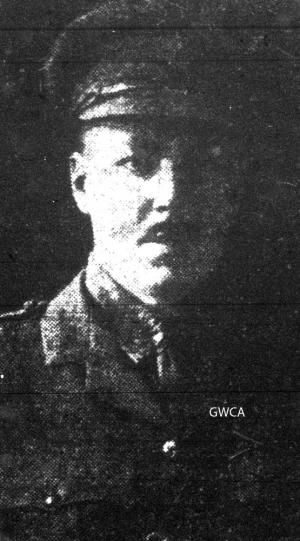BX October 12, 1915
Canadian Artillery Has Made Fine Gun Record – Landed First Shot on German Signalling Station Wiping it Out – Interesting Letter From Pte. John Frederick Lindsay Simmons, Now on Firing Line in France
Mrs. Fred Simmons, 114 Clarence Street, received an interesting letter yesterday from her son, who is now fighting in the trenches. The letter reads as follows:
September 24, 1915
Somewhere in France
Dear Mother
Well, here we are at last in the fight, right in the thick of it. All letters are vigorously censored, so you will have to go without details or information concerning our whereabouts.
We went into action yesterday, just one week after leaving England; I was billeted behind the line for three days with a French family. I can get along quite nicely with the French and it is no trouble for me to talk to them.
Let me tell you something of the actual fighting line. Believe me; it is entirely different from anything I expected. Everything seems to be going on as usual, except about two miles from the first line of trenches. Peasants are harvesting their crops and are generally doing “Business as usual.” From just where I am sitting at present I would have no idea there was a war if it wasn’t for the boom of guns and the bursting of German shells. No notice is taken of these shells whatever. They are more like fire-crackers to us. At times it is one continual war, never stopping night or day. To the south of us they are shelling some town, having blown the spire off the church not long ago.
Our 15th Battery has made a name for itself already, as it shattered a party of German signallers and their station at the first shot.
The most interesting fights are the battles in the air. The moment a German plane appears, our aerial guns open fire on them. It looks like someone throwing snowballs at a bird. This morning a German Taube got behind our lines, but a British monoplane was immediately after it and soon drove it off. Now don’t worry for me, for if you know how little I worried, you would not think much of it. Write soon.
J.F.L. Simmons
My address is:
Headquarters staff
4th Brigade, C.F.A.,
2nd Canadian Division, France,
c/o Army Post office
BX February 3, 1916
Enlist in Ranks is Advice Given – Gunner John Frederick Lindsay Simmons Tells Young Men Not to Wait For Commission
A hint for the young men at home is given in a letter received from Gunner J.F.L. Simmons with the headquarters staff of the 4th Brigade, C.F.A. He urges them to enlist as privates and not wait until they can get commissions. In a letter received here he writes in part:
Somewhere in France
So you’re proud of me, are you? Well, I’m not yellow anyway. It’s far more to my credit to be over here as a common gunner than to be bumming around home after a commission, as so many are doing, hoping in their hearts that the war will be over before they’re called upon. I may get heartily sick of latter at times, yet I wouldn’t be out of it for all the money in the world. It sure is a real man’s job, this war game. Yes, I expect there will be big doings in the spring.
J.F.L. Simmons
Headquarters Staff,
4th Brigade C.F.A.
2nd Expeditionary Force, France
BX August 15, 1916
Corporal John Frederick Lindsay Simmons Now in Hospital – Trench Fever Causes Brantford Boy to be Sent to Scotch Hospital – Horrors of Ypres
Mr. and Mrs. Fred Simmons, 114 Clarence Street, have recently received two letters from their son, Corp. John Frederick Lindsay Simmons. Corporal Simmons had some very narrow escapes in the big battles in the Ypres salient, but luckily escaped the “whiz bangs” and shrapnel. He is now in the 4th Scottish General Hospital, ward 25 B. Glasgow, Scotland convalescing from an attack of trench fever. The first letter written on July 30, tells of Corp. Simmons being in a hospital in France afflicted with the disease known as trench fever, what he terms one of the by products of the war. He states that it is not serious, but terribly annoying, as he has to lie on his back in bed all the time. “I’m just lying on my back in the cutest little bed (the first I’ve been in for a year) with snowy white sheets. The nurses are nice and pretty, especially so after seeing nothing but bucolic Belgians for so long” is the way he puts it. He adds that the symptoms of his malady are a general lack of all “pep,” aches in every joint and beastly pains in the legs, and a temperature ranging from 97 to 104 – mere trifles not worth worrying about. The second letter follows:
Weel, here I awm, awa’ up in Gasgu I the bonny land O Scotland. You see I have to talk Scotch now; everybody does of course. Even the nurses have a delightful little twist to their tongues.
Now I can easily imagine your surprise on receiving this rather startling information. Yes, I am really and truly up in Scotland. Evidently the doctors at Boulogne thought I needed a rest, so I was carried down to the hospital ship, crossed the channel and landed at Southampton! Congreg moi!” Believe me the peaceful fields of old England were a sight for sore eyes. I was carried out to the hospital train and sent directly north to Glasgow.
This hospital is a splendid place; everything possible is done for the comfort of the patients. I’m the only Canadian up here, so apparently rather a novelty. I was the only one on the boat, I believe, so was sent right along with the bunch.
Now please don’t worry about me. I’m all right and in the best of hands. Don’t get any foolish idea that I’m seriously sick. No, I’m not, just kind of worn out for the time being. Your days of worry should be over for a long while now, for it will be some time before I go back to France.
From the hospital I will take that officer’s course that I am booked for. I’ll take it in England, which will last about two months, or probably more. Then I have other plans.
So now you can cheer up, your boy’s quite safe from “Fritz” shells now. I’ll have a nice rest here for a while. I don’t know how long my legs are pretty weak and they keep me in bed.
Well now that I am away from that place called France, I suppose I can tell you more about it without fear of the censor. Of course you know that I have been at Ypres since the first of April, right in the salient. Believe me we have had some awful times; no one can ever even imagine the awfulness. I will tell you one thing that will perhaps open your eyes. Our battalion went into a big action on June 12 and came out on June 14 with but 200 left. We went in 800 strong. How I came through goodness knows. You know I am a corporal now. They gave me that distinction some months ago. I was in charge of a section of men and during the action we captured a machine gun and killed the Germans who were working it. I was the only one of my section that was not either killed or wounded, 13 of us. I was the 13th and yet they say that number is unlucky.
BC May 8, 1917
Lieutenant John Frederick Lindsay Simmons Tells of the Attack on Vimy Ridge – And the Manner in Which He Got Hurt
Mr. Simmons, 114 Clarence Street, has received the following letter from his son, Lieutenant J.F. Simmons:
“I suppose that by this time you have received my cablegram which I sent from Boulogne, France. After staying there four days, I was sent across here (London). Now you’ll excuse this writing, as I am flat on my back and can scarcely see the paper.
“I imagine you have read all about the Vimy Ridge from the start of the big offensive. I sure was in it tooth and nail, but did not last long. My company was in the first great wave to go over. One long line of men, five yards apart and 13 miles long, followed by another and another and so on, 20 yards between each wave. It had only been going one hour and was just approaching our second objective trench when a machine gun bullet hit my arm half way between my elbow and shoulder gyrating me like a top and I fell and lay in a shell hole an hour or so, then walked back holding my left arm with my right. A Red Cross man had meanwhile put a field dressing on it. The bone was smashed and broken which at present is keeping me in bed, and will be here for some weeks. Don’t worry; cheer up. Perfectly sound in health otherwise.”
Lieut. Simmons address is:
1st London General Hospital,
St. Gabriel’s College,
Camberwell, London, England

